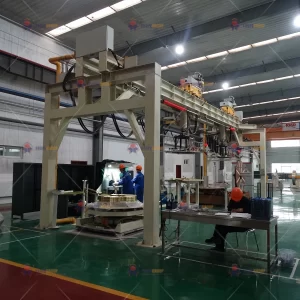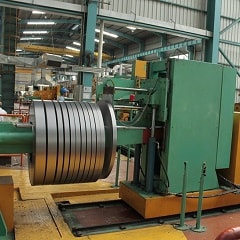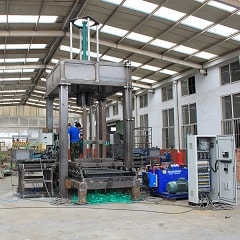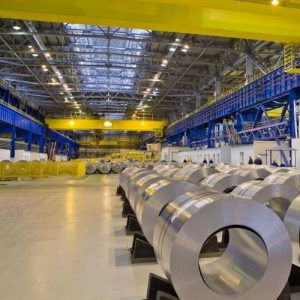Copper strip lifter and welding machineis a system or process designed to handle and transport copper strips efficiently and effectively in an industrial setting. Copper strips are thin, flat pieces of copper commonly used in various industries, including electrical, electronics, automotive, and construction.
The handling line for copper strips typically consists of several components and stages that work together to ensure the smooth movement and processing of the strips.
Coiler: Once the copper strips have undergone various processing steps, they are rewound into coils or spools using a coiler machine. The coiler prepares the strips for storage, transportation, or further downstream processes.
Transit platform, also known as a transportation platform or simply a platform, is a designated area within a transportation facility where passengers board and alight from public transportation vehicles. It serves as a point of connection between passengers and the vehicles they wish to travel on, such as buses, trains, trams, or ferries.Transit platforms are typically designed to provide a safe and convenient location for passengers to access public transportation services.
Throughout the handling line, various sensors, controllers, and automation systems may be employed to monitor and control the strip's movement, tension, speed, and other parameters. These systems help maintain optimal production efficiency while ensuring the quality of the copper strips.
Sensors and automation systems play a crucial role in monitoring and controlling the movement of copper strips in a handling line. For example,
Position Sensors: Position sensors, such as encoders or linear displacement sensors, are used to monitor the position of the copper strip as it moves along the handling line. These sensors provide feedback on the strip's location, which is essential for precise control and alignment.
Tension Sensors: Tension sensors are employed to measure the tension in the copper strip. Maintaining proper tension is critical to prevent strip slippage, wrinkles, or other handling issues. Tension sensors provide real-time feedback to the automation system, allowing it to adjust the speed of the conveyor or other components to maintain the desired tension.
Speed Sensors: Speed sensors, such as optical encoders or proximity sensors, are used to measure the speed at which the copper strip is moving. This information is utilized to synchronize the movement of various components along the handling line, ensuring smooth and coordinated operation.
Automated Control Systems: Automation systems, such as programmable logic controllers (PLCs) or computer numerical control (CNC) systems, are responsible for receiving data from the sensors and making real-time decisions to control the movement of the copper strip. These systems can automatically adjust the speed, tension, and position of the strip, ensuring precise handling and coordination between different components.
By integrating sensors and automation systems into the handling line, manufacturers can achieve higher levels of accuracy, efficiency, and productivity. These technologies enable real-time monitoring, feedback, and control, minimizing errors, reducing downtime, and optimizing the overall performance of the copper strip handling process.
The integration of vacuum chucks in the welding process can improve efficiency in several ways:
Secure Coil Positioning: Vacuum chucks provide a reliable and secure grip on the copper coils, holding them firmly in place during welding. This eliminates the need for manual handling or clamping, reducing the time and effort required to position the coils accurately. The coils remain stable and fixed, ensuring consistent alignment and minimizing the risk of movement or misalignment during the welding process.
Quick and Easy Coil Transfer: Vacuum chucks enable fast and efficient transfer of the copper coils between different stages of the welding process. The vacuum system can quickly attach and release the coils, streamlining the workflow and minimizing downtime. This allows for smooth and continuous movement of the coils, enhancing overall productivity.
Precise and Repeatable Positioning: Vacuum chucks offer precise control over the positioning of the copper coils. The vacuum force can be adjusted to ensure optimal contact and alignment with the welding equipment. This precision helps maintain consistent weld quality and reduces the need for rework or adjustments due to misaligned coils.
Minimized Coil Damage: The use of vacuum chucks minimizes the risk of coil damage during the welding process. Traditional clamping methods can cause deformation or distortion of the coils, affecting the quality and integrity of the welds. Vacuum chucks provide a gentle and even distribution of holding force, reducing the potential for coil damage and ensuring the integrity of the finished product.
Enhanced Operator Safety: Vacuum chucks contribute to operator safety by reducing the need for manual handling of heavy or awkwardly shaped copper coils. This minimizes the risk of strain or injury associated with lifting and positioning the coils manually. Operators can focus on the welding process itself, improving overall safety and reducing the likelihood of accidents.
It's important to note that the specific configuration and components of a copper strip handling line can vary depending on the industry, production requirements, and the size and thickness of the copper strips being handled.






Reviews
There are no reviews yet.